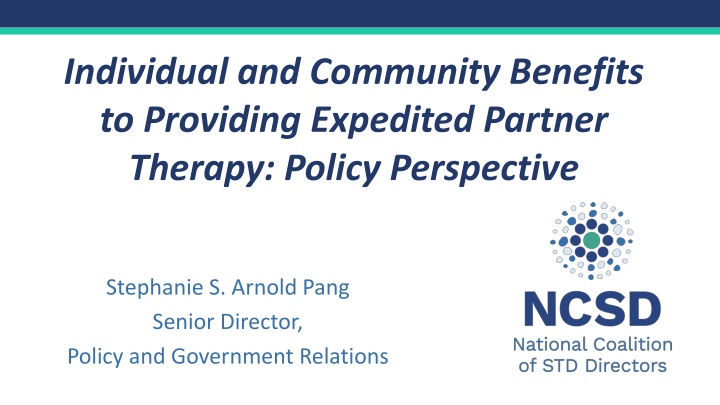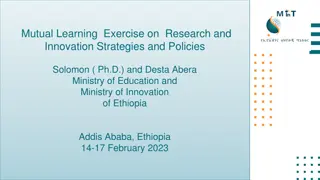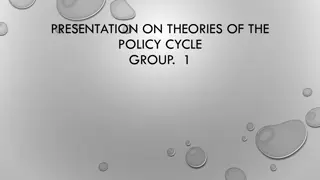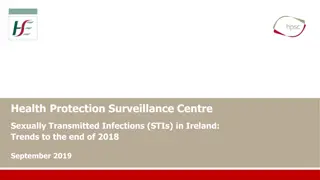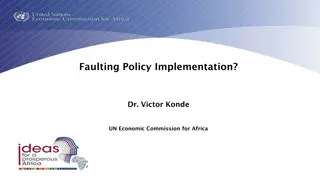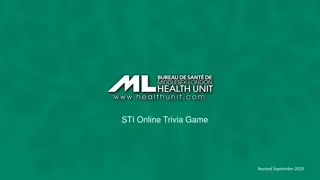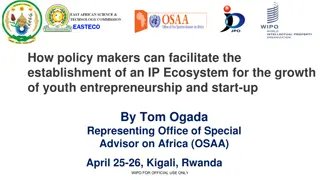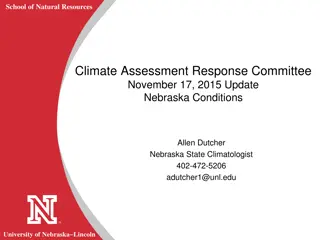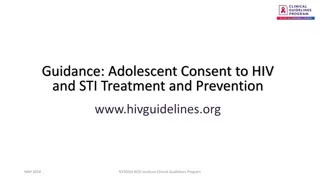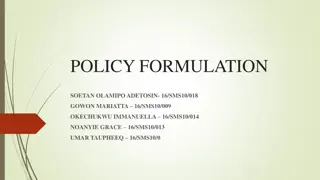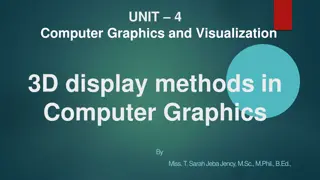Addressing STI Trends and Impacts: A Policy Perspective
Explores the benefits of Expedited Partner Therapy (EPT) in combating STIs, focusing on policy perspectives, challenges, and successes. The presentation sheds light on the current state of STIs, emphasizing the rise in rates across states like Missouri. It also highlights the mission and vision of the National Coalition of STD Directors in promoting effective STI prevention programs and services to achieve a nation free of sexually transmitted diseases.
Download Presentation

Please find below an Image/Link to download the presentation.
The content on the website is provided AS IS for your information and personal use only. It may not be sold, licensed, or shared on other websites without obtaining consent from the author.If you encounter any issues during the download, it is possible that the publisher has removed the file from their server.
You are allowed to download the files provided on this website for personal or commercial use, subject to the condition that they are used lawfully. All files are the property of their respective owners.
The content on the website is provided AS IS for your information and personal use only. It may not be sold, licensed, or shared on other websites without obtaining consent from the author.
E N D
Presentation Transcript
Individual and Community Benefits to Providing Expedited Partner Therapy: Policy Perspective Stephanie S. Arnold Pang Senior Director, Policy and Government Relations
CHAT CHAT IN -- Where are you/your agency located? (state, type of organization, urban or rural?) 2
Disclosure Disclosure: Stephanie Arnold Pang has no financial interest to disclose. 3
Goals of Presentation State of STIs Overview of EPT Discuss Policy Success and Barriers 4
NCSD Mission & Vision MISSION To advance effective STI prevention programs and services in every community across the country. NCSD does this as the voice of our membership. We provide leadership, build capacity, convene partners, and advocate. VISION A nation without sexually transmitted diseases. Revisiting our mission & vision: Moving towards a sexual health & wellbeing framework, and away from a disease model. 5
What We Do Capacity Building Policy &Advocacy National Leadership & Strategic Communications Promoting Health Equity Organizational Strengthening 6
Why We Do It Gonorrhea Syphilis Chlamydia Congenital Syphilis https://www.cdc.gov/std/statistics/2021/default.htm, accessed May 1, 2023 7
Chlamydia Rates of Reported Cases by State, United States and Territories, 2012 and 2021 * Per 100,000 9
Gonorrhea Rates of Reported Cases by State, United States and Territories, 2012 and 2021 * Per 100,000 10
Missouri Stats From 2012 to 2021 in MO: CS rates up 7,208% Syphilis rates up 826% Gonorrhea rates up 96% Chlamydia rates up 11% In 2021 alone: 49,798 STI diagnoses . MO ranked 13th in the US for chlamydia diagnoses among young people (13-24) . 48% of the state's gonorrhea cases were among Black people (who are 12% of the population). 11
Kansas Stats From 2012 to 2021 in KS: Syphilis rates up 470% Gonorrhea rates up 149% CS rates up 100% Chlamydia rates up 37% In 2021 alone: 21,044 STI diagnoses . KS ranked 20th in the US for chlamydia diagnoses among young people (13-24) . 30% of the state's gonorrhea cases were among Black people (who are 6% of the population). 12
Why STD Prevention is Important Nearly $16 billion in direct medical costs every year Higher risk of HIV infection Higher risk of certain cancers STDs in Pregnancy: fetal death, disabilities, prematurity Women are particularly vulnerable to STDs and their consequences Infertility Ectopic Pregnancy Pregnancy loss and still birth 13
Tools for STD Prevention Primary prevention Behavior change Primary and secondary prevention Case-finding & treatment Increase screening Rescreening Improve partner treatment 14
Role of Public Health Partner notification and contact tracing key underpinning of public STD programs Disease Intervention Specialists (DIS) interview people with an STD Receives contact information, attempts to contact those partners Goal: Partners are tested and treated 15
DIS for Every STD?? Public health does not have resources to follow-up on all STD cases Private sector health challenges as well Due to financial and personnel constraints, STD programs often focus on only syphilis and HIV A new option for the treatment of partners is needed 16
Poll Do you/your organization provide expedited partner therapy now? YES NO 20
What is Expedited Partner Therapy? Harm reduction strategy of treating the sex partners of persons with STIs chlamydia and gonorrhea without an intervening medical evaluation EPT allows health care professional to provide patients with antibiotics or prescriptions for their partners without requiring a visit by that partner Treatment of the partner is critical to preventing reinfection, reducing STI rates 21
Poll If you DO provide expedited partner therapy, for which STIs do you provide medications? (check all that apply) Chlamydia Gonorrhea Trichomoniasis Other 22
Poll If you DO provide expedited partner therapy, which mechanism of distribution/administration is the most common? Dispense at clinic to index patient to deliver to partners Provide prescriptions to index patient for partners Provide prescriptions for more than one dose of medication to index patient so they can deliver to their partners Make phone or telehealth contact with partners and provide medication after consultation with partners Other 23
Organizations that Support EPT Centers for Disease Control and Prevention American Academy of Family Physicians American Bar Assoc. American College Health Assoc. American College of Obstetricians and Gynecologists American Osteopathic Association Council of State Governments Natl Assoc. of County and City Health Officials National Coalition of STD Directors Society for Adolescent Health and Medicine 24
CDC EPT Map https://www.cdc.gov/std /ept/default.htm www.cdc.gov/std/ept/le gal/legaltoolkit.htm The Legal Aspects of EPT Practice: Do State Laws and Polices Really Matter? 25
Poll If you DO NOT currently provide EPT, are there plans in place for you/your organization to provide expedited partner therapy in the future? YES NO 26
Poll If you/your agency plan to provide expedited partner therapy in the future, for which STIs will you provide medications? (check all that apply) Chlamydia Gonorrhea Trichomoniasis Other 27
Poll If you plan to provide expedited partner therapy in the future, by what mechanisms will you provide the medications? Dispense to index patient to deliver to partners Provide prescriptions to index patient to deliver to partners Other 28
CHAT If your agency DOES NOT currently provide EPT - - CHAT IN what are the primary barriers? 29
Barriers to EPT Lack of awareness/provider buy-in Cost/access to medication Concerns regarding gonorrhea resistance Concerns regarding drug allergies 30
CHAT If you/your agency currently provides EPT CHAT IN what are/were the facilitators that made it happen? 31
Mitigating EPT Barriers Frequent provider education, resources Patient Materials Provide EPT packs 340B, Medicaid/ FP waiver reimbursement EPT Subcommittees, Community Engagement 32
Mitigating Barriers NCSD Resource! https://www.ncsddc.org/resource/expedited-partner-therapy 33
Stephanie S. Arnold Pang sarnold@ncsddc.org www.ncsddc.org
